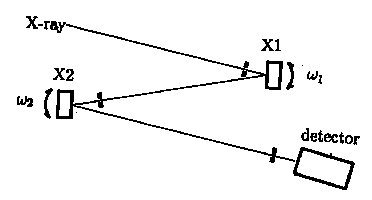
EXAMINATION OF HIGH-ANGLE DOUBLE-CRYSTAL X-RAY DIFFRACTOMETRY (HADOX). By Y.Fujii, Y.Soejima and A.Okazaki Department of Physics, Kyushu University, Fukuoka 812-81, Japan
The HADOX method has been used since the seventies in the determination of the temperature dependence of the lattice spacing d(T) in a relative precision to 10-6
-10-7, and in the characterization of crystals. In the circumstances where synchrotron X-rays are available, the performance of the method is systematically reexamined for crystals of different qualities. In the figure given below, the experimental arrangement in HADOX is schematically shown. X-rays are successively diffracted by two crystals X1 and X2; the Bragg's law is given by d1 sin [[theta]]1 = d2 sin [[theta]]2 where suffixes 1 and 2 denote X1 and X2 respectively. In HADOX, the two arrangements A and B can be used, X1 and X2 being used as follows:
in A, X1 as a monochromator and X2 as a specimen, and
in B, X1 as a specimen and X2 as an analyzer.
In both A and B, a change in d of the specimen crystal can be determined from a change in [[omega]]2. In A, however, the change in [[omega]]2 may include contributions from a twist of the specimen holder etc. when the temperature is varied. In B, the X-ray wavelength at the detector varies when d1 varies. If a conventional X-ray source is used, this may require to use white X-rays, and the intensity will be a serious problem. Combinations of crystals with FWHM in [[omega]] 50, 300 and 500 urad are examined in connection with the determination of d(T) and the characterization of crystals.
